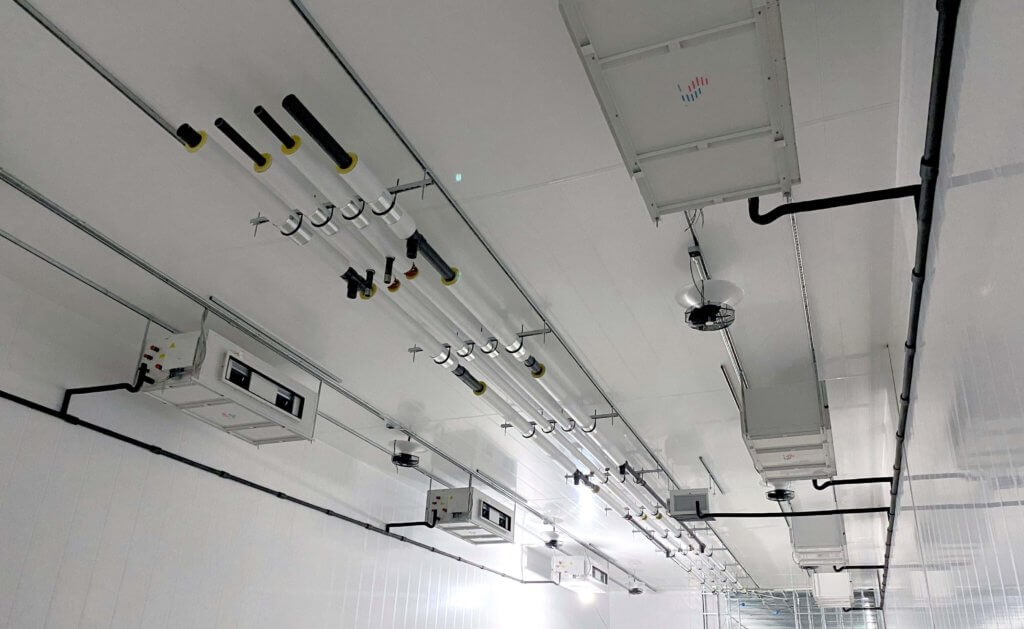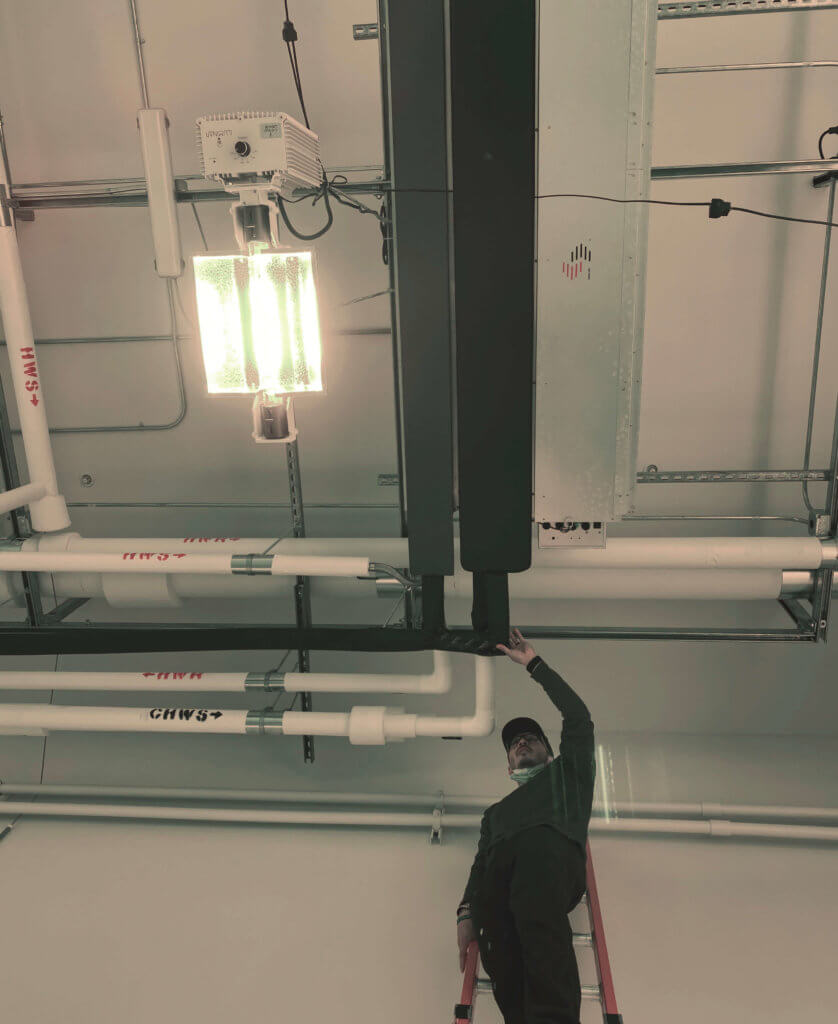Growing plants indoors requires a lot of energy. If you are planning an indoor cultivation facility, you need to make sure that you are using the right type of heating or cooling system. There are many types of systems to choose from, including direct expansion (DX), split systems, VRF, hydronic, and more. This article will explain what hydronic cooling is and its benefits.
A hydronic system is a type of heating and cooling method that uses water instead of air to heat and cool your grow room. It is also known as chilled water cooling because it uses water as a heat exchange medium.
Hydronic cooling can be a great option for many cultivators. This method of climate control has a number of energy efficient options, allows for flexibility in air handling approaches, and utilizes chillers that are intended for heavy, year round use, with results in superior longevity in most cases. Properly designed systems can also provide high consistency in temperature and humidity throughout the grow space. Well-designed hydronic systems are great for growing cannabis, vegetables, leafy greens, and other crops indoors.
How Does Hydronic Cooling Work?
The air handling component of hydronic systems works similarly to traditional air conditioners. Hot, humid room air is passed over a heat exchanger, where heat and humidity are removed. Then, the cool, dry air is returned to the space. However, in hydronic systems, the heat exchange medium in the air handlers or fan coils is water instead of refrigerant. In a chilled water system, the heat exchanger transfers heat from the air to the water.
The heated water then leaves the room through a network of sealed pipes. It is sent to a chiller plant, dry cooler, or other central unit where the heat absorbed into the water is rejected to the outside, and cold water is returned to the air handlers or fan coils inside the building. In most cases, chiller plants are located outside the building, although some water-cooled or heat recovery units may be located inside, usually in a designated mechanical room.
Check out this helpful animation:

Can a Hydronic System Be Used For Heating?
While grow lights and plant transpiration can generate their own heat, indoor farms in cooler regions will still need to add heat to their gardens during the cold months if they want to harvest all-year-round.
Yes, hydronic systems can be used for heating. As with cooling, these systems use water to transfer heat from one place to another. With hydronic heating, the water is either heated within the central unit and then sent to the grow room air handlers or fan coils, or it can be heated within the room’s units themselves. The air within the space passes over the heat exchanger where it removes the heat from the water and transfers it to the air.
This process requires units that have both cooling and heating capabilities, and there are a number of options for accomplishing this. Fan coils and air handler units can come equipped with electric heaters in which electricity is used to generate heat, although this is not done using hydronic heat. For that, they must have a separate set of pipes that allow for water heated by the central unit outside the space to enter the grow space via the same process as the chilled water.
That is what we mean when we differentiate between 2-pipe and 4-pipe chilled water systems. A 2-pipe chilled water system uses units with 2-pipes; one for the cooled water to enter, and one for the water to leave once it’s removed the heat from the air. A 4-pipe chilled water system is capable of hydronic cooling and heating, with two additional pipes; one for the heated water to enter, and one for the water to leave once the air has removed its heat.

Why Choose a Hydronic System?
Hydronic systems can be an efficient and effective option for cooling, heating and dehumidifying your indoor farm. They offer several ways to improve energy efficiency in cultivation operations, from numerous free cooling options (without requiring ventilation in the cultivation space), to integrated dehumidification, to high efficiency, industrial grade chiller plants.
Not only this, but you can also choose to integrate your chilled water HVAC system with your irrigation system. This is exactly what Durango Cannabis Company did. They can reclaim the water collected by their dehumidifiers and reuse it to water their plants. By minimizing their water waste, they are able to achieve a $30 average monthly water bill.
Hydronic systems also provide significant flexibility in air handling options and the ability to adjust to changing parameters. Even with very large scale systems, ductless options can be integrated if desired, which doesn’t make sense with refrigerant based systems where compressor and fan coil tonnage must be closely correlated. In hydronic systems, there are endless possible combinations of air handler sizes that can be applied within a given tonnage of compressors.
Another advantage of chilled water cooling and heating is that it uses water pipes instead of bulky ductwork. One of the biggest differences between hydronic and forced air systems is chilled water’s ability to move BTU’s quickly and efficiently. According to ASHARE, a 3-in. diameter chilled water pipe can carry 1,000,000 BTU’s of cooling, while a 70-in. x 46-in. air duct would be necessary to accomplish the same task with air. This is because water is a better thermal conductor than air.
In ASHARE’s example, it may take a 2 horsepower pump to move water around the building. In a forced air system, 60-100HP fans would be needed to move the air as needed. This example demonstrates how much less horsepower (transport energy) chilled water needs to move BTU’s around. This helps save energy and provides flexibility in getting capacity where you need it, when you need it.
How Much Does it Cost?
If you’ve read this far, you may be ready to jump aboard the hydronic train. But before you do, it’s important to look at all the options.
Hydronic systems can be a great option for many growers. But there are many variables to consider when budgeting for your mechanical system. While it is one of the more efficient and flexible methods for temperature control, the initial investment for a water cooled system can be high. It will also require extra careful selection when choosing a company to install everything, as the application of hydronic systems requires specialty expertise. It’s difficult to put a number on something subject to so many variables. A hydronic cooling system can vary in price depending on the size and location of your facility, infrastructure needs, lighting and watering schedules, specific equipment selection, and more. Remember that you have many options when it comes to your HVAC system, so work with a mechanical engineering team to help find the best fit for you.

An Efficient Option
Ultimately, there are many choices for heating and cooling your indoor farm. A hydronic system can offer greater energy and water efficiency. They can also eliminate the need for ductwork, saving space and reducing contamination risks. For cannabis cultivators, this offers the added benefit of odor control. These systems can come with a price tag, though. So it is important to work with an experienced MEP engineer when deciding if hydronic cooling is the way to go. You should take into account your geographic location, infrastructure availability, required climate parameters, access to water, odor regulations, local codes, and more before deciding on the type of system that will work best for your farm.
Ready to evaluate your HVAC options? Contact us.

